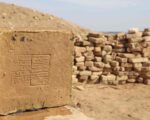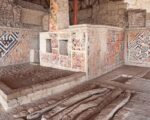Remarkable Discovery of 50 Viking Age Burials in Denmark: Unveiling Insights into a Lost Era
A groundbreaking archaeological discovery in Denmark has unveiled a burial ground containing approximately 50 Viking Age individuals, dating back to the 900s. This significant find was made during preparatory work for electrical cable installation near the village of Åsum on the island of Funen. Over the past six months, archaeologists from Museum Odense have excavated these graves, providing a unique opportunity to study human remains from a pivotal era in Scandinavian history.
One of the most noteworthy aspects of this discovery is the unusual preservation of the skeletal remains, which is a rarity in Scandinavia due to the region’s acidic soil that often hampers bone retention. The excavation of 50 graves represents a critical breakthrough, as it allows researchers to conduct various scientific analyses that could offer insights into the health, diet, and origins of the individuals interred at the site. Archaeologist Michael Borre Lundø from Museum Odense emphasized the exceptional nature of this find, highlighting its potential to enhance our understanding of Viking culture and society.
The burial ground not only provides a glimpse into the physical remains of the Viking Age but also offers insights into the social hierarchy of the time. Many of the individuals buried at this site appear to have held high status, as evidenced by the grave goods found alongside them. For instance, one notable burial features a woman interred in a Viking wagon, surrounded by luxurious items that include a beautiful glass bead necklace, an iron key, a knife adorned with a silver-threaded handle, and a small glass shard likely used as an amulet. These artifacts indicate the importance of burial customs and the significance of material wealth in Viking society.
In addition to personal items, the graves may also contain evidence of burial practices and rituals that can help researchers piece together the cultural practices of the Vikings. The presence of certain artifacts may provide clues about the individuals’ occupations, social standing, and even their beliefs about the afterlife. As archaeologists continue to analyze the site, they hope to uncover more information about the relationships between those buried and the broader Viking community.
This discovery has sparked excitement within the archaeological community, as it comes at a time when interest in Viking history is at an all-time high. The Viking Age, known for its maritime exploration, trade, and cultural exchange, remains a fascinating subject for historians and enthusiasts alike. By shedding light on the lives and customs of those who lived during this era, the findings from Åsum could significantly enhance our understanding of Viking society and its impact on the region.
As research progresses, the artifacts and remains from this burial site are expected to provide a wealth of information, potentially leading to new interpretations of Viking life and culture. The excavation serves as a reminder of the importance of archaeological work in uncovering the past, and it underscores the ongoing relevance of Viking heritage in modern Denmark. With continued study and analysis, the findings from this burial ground may not only illuminate the lives of those who came before us but also inspire a deeper appreciation for the rich history that shapes our present.


















